The Ar15 Scope or Red Dot Sight
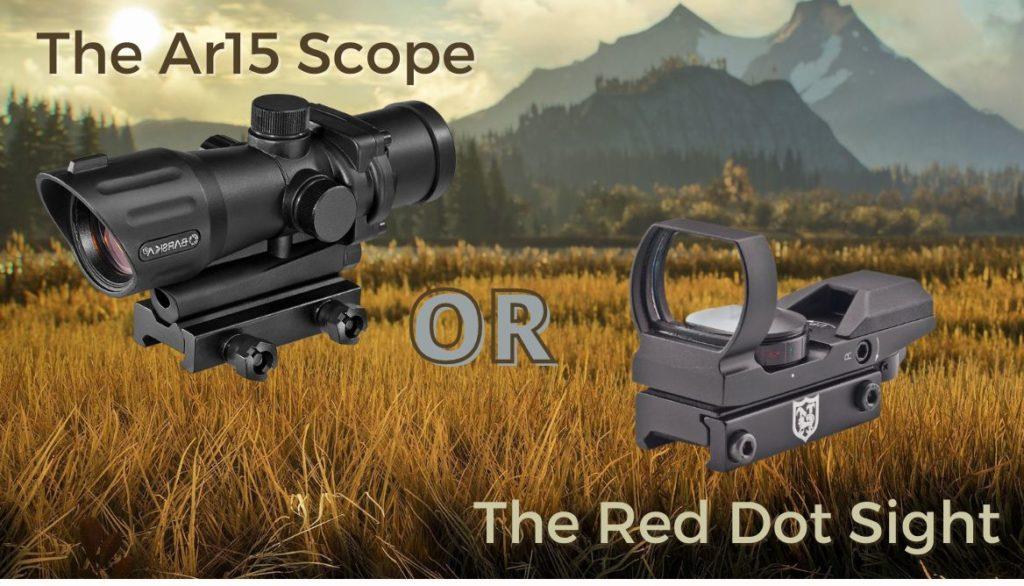
You are faced with a difficult choice and cannot choose between ar15 scope or red dot. It all depends on what your basic requirements are for optics for your rifle.
I suggest you look at their basic characteristics together, such as:
- Precision
- Hunting
- Target Shooting
- Competition
- Speed
- Weight & Size
- Battery Life (for Red Dot)
And also dive deeper into the pros and cons of the AR15 Scope and Red Dot Sight.
What is “a red dot”?

One of the most common types of firearm sights is red dot sights.
A red dot sight is a type of optic having its reticle as a red dot. An optical tool’s reticle is a dot or line that serves as a measuring scale and aids in object location frequently used at shorter distances, typically less than 100 yards. They help novice shooters with simpler aiming and are incredibly simple to use.
Red dot sights are typically battery-powered and display a red dot on the target that can be perfectly aligned with the gun’s sights.
When you pull the trigger, the sight fires, and the bullet is guided to the target by the red dot.
There are several types of red dot sights, each with its own price and set of features. Some red dot sights are only intended for use with pistols, while others can be used with rifles as well.
What is a magnified optic?

These are optical telescopes that, when activated, magnify the shooter’s field of view. They are frequently mounted behind non-magnified sights that produce a collimated reticle image, such as red dots, holographics , or other non-magnified sights.
Typically, magnified optics are 3X telescopes, but they can also be 2-8X or more. Police and Special Operations Forces may make use of them to engage distant targets thanks to the magnifier optics. The increased magnification can help hunters distinguish between targets when prey are difficult to see in brush or vegetation.
Rifle scope Or Red dot: How to choose?
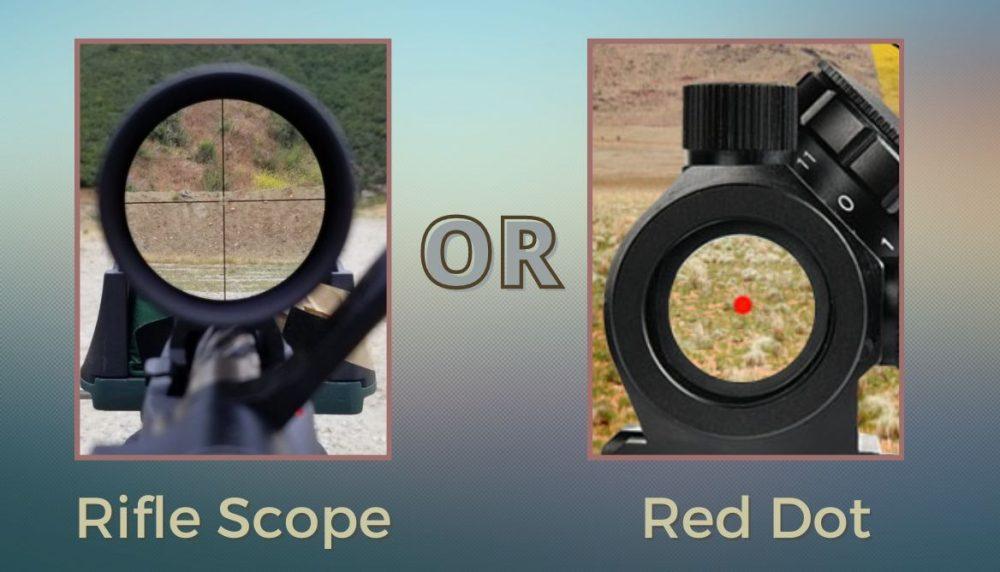
The age-old dilemma for many shooters, both the first timers and the seasoned shooters is selecting their target equipment because it will ultimately determine how well they take that shot. The red dot sight and the rifle scope are two fundamental ideas in the field of sighting optics. What factors ought you to weigh when deciding between the two?
The decision between the two is largely influenced by personal preference, the type of shooting you will do (long or short range), the visibility of the reticle, the weight and size of the optic and mounting system, the cost of the optics relative to the derived value, the intended speed, and the level of competition.
However, let’s review them in detail.
What magnification is needed for an AR15?

Close Range (<150 yards)
the AR 15 shines at close-range battles therefore making it a powerful tool for target shooting or small game hunting.
The magnification power of 1 – 4X is highly recommended.
You can also use an AR-15 red dot for quick target acquisition at close range.
Medium range ( 150-400 Yards)
The 200-yard scope magnification will be low power and will most likely be used for target shooting, hunting, or close engagements for home defense. Fast target acquisition and a wide field of view are critical considerations.
A general-purpose Magnifying configuration of 5-9x is highly recommended for target range shooting and hunting within 150-400 yards. The hunting range is located here.
Most people use their AR-15 scope to protect their homes’ from roaming wild animals.
Long Range (400+ yards)
The 400-yard scope magnification will be low power and will most likely be used for target shooting, hunting, or close-range engagements for home defense or LE applications. Fast target acquisition and a wide field of view are critical considerations.
Shooting at 400 yards is considered long-range, and most modern rifle scopes are equipped with magnification and reticles for distances of 400 yards and beyond.
The following is the recommended long-range magnification: 9X and higher.
High power is usually required for competitions, but many people use 12-18x magnification.
Various factors also affect the magnification needed and this includes: target size, wind, reticle type, and optical quality
Precision

The red dot is typically quick to use and works best for close-range distances. It provides many benefits that the rifle scope cannot match. Rifle scopes, on the other hand, provide greater precision at greater distances with magnification that enables you to see and place crosshairs on the target.
AR15
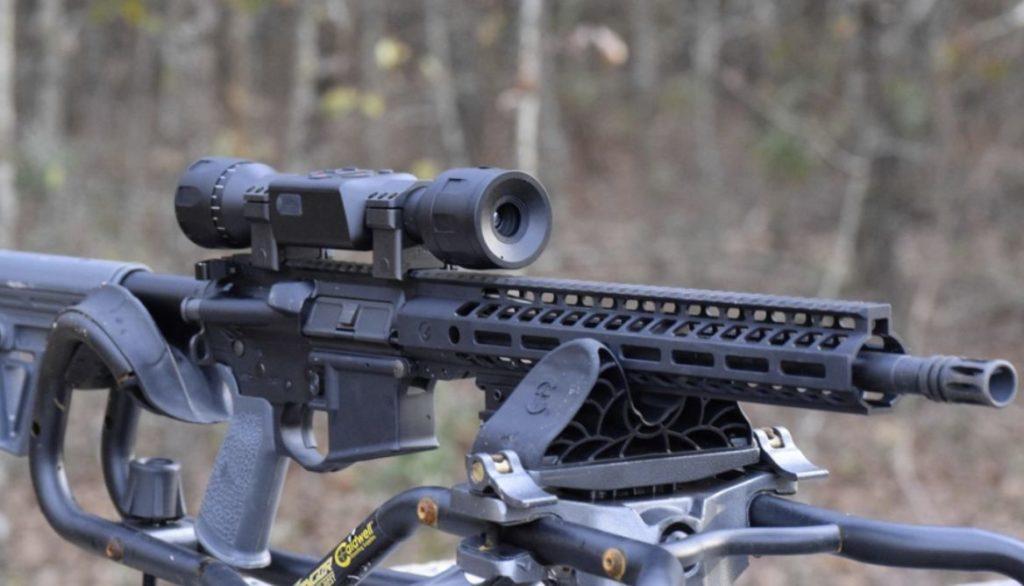
The extremely modular design of the modern AR makes it possible to attach a seemingly limitless variety of “stuff” to it.
The AR has typically been equipped with a red dot optic. The AR-15 red dot sight can be used for targets farther away than 100 yards, especially when used in conjunction with a magnifier.
They take up little room on the rail, are quick to use, and are simple to train with. They can also be used with a variety of other optics and accessories. It is also a desirable optic due to the maxim “if you can see the dot, you can make the shot.”
However, in bid to improve the MSR’s performance over long distances,magnified scopes are also mounted. Manufacture have combined the two technologies of rifle scopes and red dot sights to create the LPVO (Low Powered Variable Optic).
It has all the advantages of a red dot with true 1x magnification and the rifle scope’s variable power and longer engagement range. For those who find themselves in this type of red dot versus rifle scope situation, the LPVO may very well be the ideal match for the AR.
Hunting
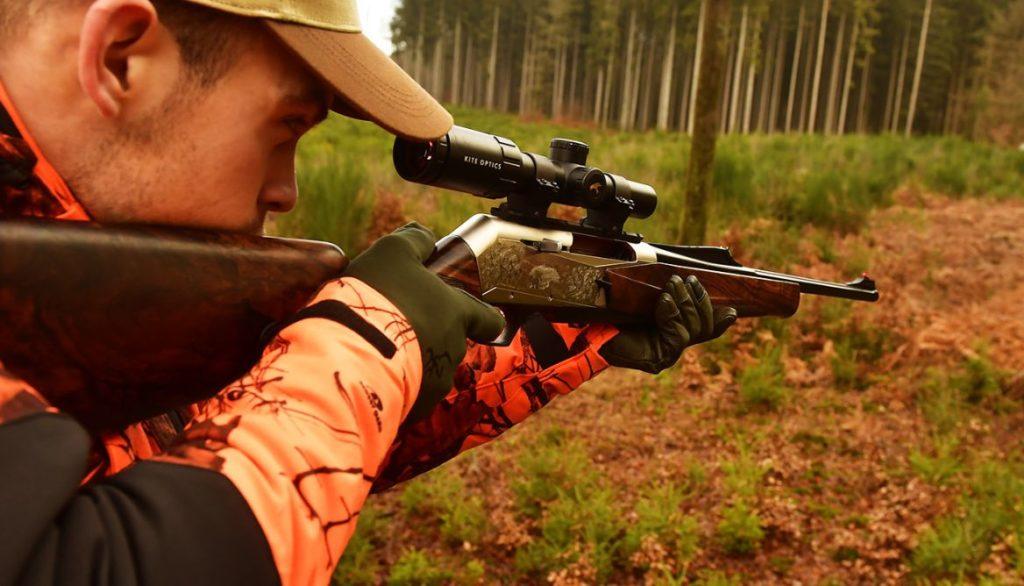
When hunting, both kinds of optics are employed. The decision will be influenced by a variety of elements, such as weatherproofing, environment, hunting grounds, type of firearm, etc.
A red dot sight will be a suitable optic at close ranges of 100 yards or less. In these circumstances and situations, their quick target acquisition and close-range advantages will be valued, especially if both you and the target are moving.
Magnified optics won’t improve your shooting, but they can help you see more clearly, especially if you’re hunting in open terrain. For the ranges and settings that most hunters use, a hunting scope configuration with 3-9x magnification is very common. They give you the ability to aim and fire at distant targets of any size.
Target Shooting
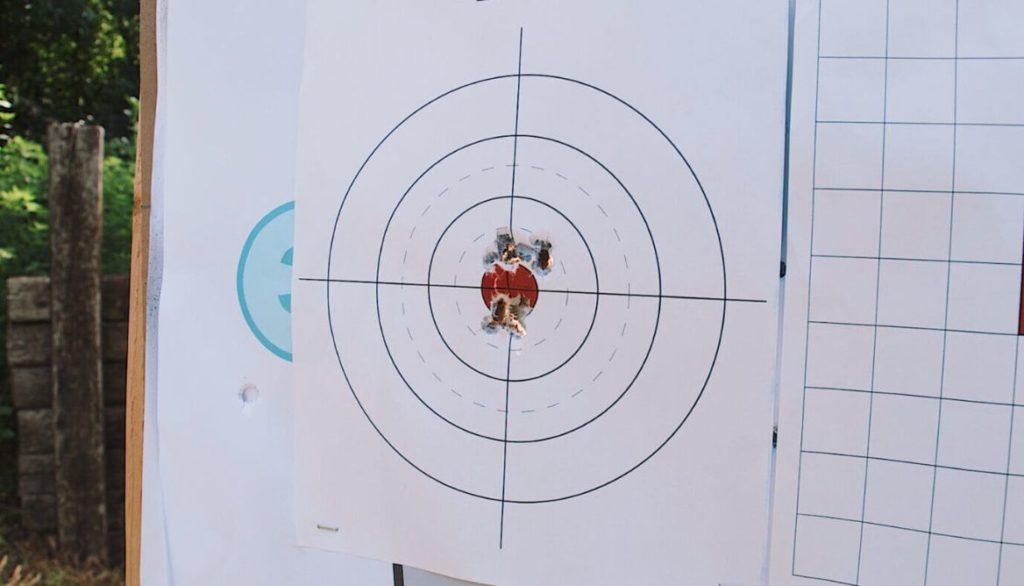
Whether using a red dot sight or rifle scope, target or range shooting is enjoyable for plinking, sighting in an optic, or simply to maintain your marksmanship skills.
A red dot sight can assist you in hitting the target every time if you frequently shoot at distances of less than 100 yards.
However, a scope will complement your shooting style if you frequently shoot from a bench or extend your range past 100 yards.
If frequent trips to the target range are your main motivation, think about the range’s distance restrictions and whether you typically shoot from prone or dynamic positions. Accuracy can also be determined by your rifle, the distance, and your shooting skills.
Competition
Many competition matches require shooting at very close ranges or longer distances.
Magnification and distance are both involved .Red dots are excellent for quick shooting at close range targets, but getting that dot to earn more points at a greater distance requires deliberate aiming and pinpoint accuracy, not just hitting the target.
However, new configurations have emerged. Whenever necessary, the magnifier can be swung in and out of position. a rifle scope and red dot combination, for instance. The benefit of using a red dot for close-range engagement with a swing mount or an offset mount
Throw levers are frequently included in competition scopes so that the user can quickly switch between high and low magnification. However, even the lesser powers might not be able to rival the power of a red dot.
both have proved useful in competitions.
Speed
Red dots are just designed for speed…
They have an unlimited eye relief to begin with, and are parallax-free. so, getting a sight picture is quick and simple from almost any head position.Additionally, most red dots have a reticle that is either actually made to shoot quickly or has a quick, simple dot pattern.
Compared to rifle scopes or iron sights, the red dot optic is much more speed-conscious.
The illuminated red dot is obviously straightforward, appealing to the eye, and designed for quick aim and fire. Target acquisition is sped up even more when you have unlimited eye relief, a true 1x magnification, and an unlimited field of view.
These are key characteristics of a red dot that make it useful for engagements in close quarter battles, tactical use and home defense.
Regarding the rifle scope, taking the time to align the rifle with the shoulder, aligning the eyes with the eyebox, adjusting the magnification, and then focusing on the target takes time that you might not have.
Weight & Size
Red dot sights are more tiny magnified scopes. The red dot sight magnified scope, which typically weighs less than 16 oz, is a lightweight optic for an AR-15 and has more accessories than it really needs.
Scopes have significantly more glass and magnification, which adds bulk and length. They can be as light as 10 oz, but most are between 16 and 25 oz.
Heavier and larger rifle scopes usually have 30mm and 34mm thick tubes, high variable magnification (Ex. 5-25x), and large objective bells with apertures greater than 44mm.
The mounting systems for both scopes and red dots will add weight to the overall package. The optical size and mounting system must be considered because they can have an impact on the mounting profile.
Visibilty Being able to see your reticle through a scope is different from a red dotsight. With both red dot sights and magnified scopes, there are different kinds of reticles, and pre-existing vision impairments can affect focus and seeing quality.
Red dots are very well-liked for their illumination and straightforward dot reticle, but astigmatic people will find it challenging to use them. The dot may resemble clusters, comets with tails, smudges, double dots, double clusters, or some other anomaly. The shooter might need to consider prismatic sights in order to possibly lessen aberrations.
When compared to red dot sights, a magnified rifle scope allows shooters to overcome vision-related challenges.
Battery Life of Red Dot
Reliability is critical for battery life. A critical factor for red dots, because no dot is visible if the battery runs out.
Because battery technology has advanced so much, some red dots can now be left turned on for 3-5 years.
If you intend to leave your red dot on all the time, the auto on/off feature is a plus.
cold weather depletes battery power faster therefore If you live in a colder climate, you should prepare a backup of your battery frequently.
Do You Have Vision Problems?
An optic with a larger field of view typically provides a sharper reticle for shooters with astigmatism or other vision problems. This is due to the reticle’s manual eyeball focus feature.
Astigmatic people may have fuzzy red dot optics, and red dot sights cannot be focused. Some prism-style optics are not magnified at all. For shooters with visual problems, these optics can be a decent .
Red Dot VS Scope Pros & Cons
Red Dot sights Pros and Cons
Red Dot Sight Pros
1. A Red dot optic improves distance accuracy. This allows for a clear view of the target.
2. Extremely noticeable in low light. You can change the brightness of your red or green dot on the majority of models to suit your surroundings. In bright daylight, you can turn it up while in dim light, you can turn it down. Even when wearing night vision goggles, where your night sights would be invisible, the dot is still noticeable.
3. It may be simpler to see red dots. If you have trouble seeing your iron sights clearly, adding a red dot can help you shoot more accurately.
4. Faster acquisition of targets. An excellent red dot has a clear, bright reticle that is simple to see in almost any lighting situation. Your focus is immediately drawn to the reticle and the aiming point.
5. A red Dot allows Shooting with both eyes open – this enables you to maintain a full field of vision and maximum situational awareness. Unlike iron sights and other magnified scopes, red dots are made specifically for shooting while keeping both eyes open.
6. Compared to other sights, red dot provides a much clearer view of the target, the point of aim, and the space beneath it.
7. Unlimited eye relief. Improved Accuracy – Compared to iron sights, red dot optics don’t demand you to be aware of your focal plane. As a result, manual sighting is no longer subject to human error, which can reduce accuracy.
As soon as they have been properly sighted in, red dot reticles are extremely accurate. a red dot sight’s accuracy gives the impression that the target is “wearing” the dot. Due to this, aiming becomes substantially simplified and accuracy increases.
8. Speed – the red dot sight is extremely capable of firing quickly. This makes it an excellent feature in Close Quater Battle engagements, tactical use, and home defense applications.
9. No magnification, hence there is also no visual distortion.
10. Excellent in dimly lit areas and even in complete darkness – For shooting in dimly lit or extremely low-light conditions, a red dot sight is the obvious choice.
11. Powered variable settings for easier adjustments.
12. Affordability. The price of red dot sights is a desirable quality for many shooters. For many shooters, red dot optics are an excellent entry sight because they can be among the least expensive sights on the market compared to the magnified optics. The most expensive holographic sights are actually only slightly more expensive than the most expensive red dot sights.
13. Weight and Size. Red dot optics are available in a wide range of weights and sizes. Some of these optics even resemble and mirror common optical scopes in appearance. Numerous semi-automatic pistols have other rounds that are compact and light enough to wind on the slide. Almost any firearm can be fitted with a red dot scope, in general.
14. Improved eye comfort. useful for those suffering from astigmatism.
Red Dot Sight Cons
1. Red Dot Sights are useless in close ins. Even though Red Dots are superior to iron sights, they are less useful for close-range defensive applications because the majority of defensive situations occur within 15 feet.
2. A Red Dot optic require practice to regain your aiming eye. The use of Red Dots is entirely different if you’ve previously used iron sights as your primary means of targeting.
3. Need for frequent battery replacement. Red dot sights require a power source to illuminate the target. If the shooter’s iron sights have been removed and the battery fails at an inconvenient time, they might not have any other options for aiming. Additionally, batteries will need to be kept near the shooting area, taking up some room in the shooter’s limited capacity equipment.
4. Red dots are expensive. The Standard issue are quite expensive, and prices keep rising as technology advances. Although some inexpensive red dot sights for beginners are available, be sure you know what you want to achieve with red dots.
Rifle Scope Pros & Cons
Pros
1. Made for large targets shooting and hunting.
2. Perfect precision shooting.
3. The scope is not reliant on battery for reticle illumination.
4. Perfect for long range shooting.
5. Shot placement is a bit consistent compared to the red dot sights.
Cons
1. Heavy and more bulky compared to iron sights.
2. More time taken to identify the target due to high magnification as compared to iron sights and red dots.
So, Which Is The Better Option?
Weight – a red dot is perfect due to its lightness and ability to shoot quickly upclose.
Precision – the rifle scope will be an ideal solution in this case and particularly for long distance targets.
Close range shooting – the red dot sight is perfect for this. Its low magnification means your sight wont be distorted.
Long distance shooting. – the rifle scope has goot you covered. Its precision, magnification power and consistency makes it a perfect tool.
When to Choose a Red Dot Scope
A red dot is ideal for close quater battles, low light situations for instance when night hunting, or self defense
Incase you have an astigmatic eye condition, a red dot scope is ideal.
When hunting large targets.
When to Choose a Magnified Scope?
The magnified scope is ideal for long distance shooting. Its precision, magnification power and consistency makes it a perfect tool.
FAQ
How Accurate Is a Red Dot Scope?
With a red dot optic, you can shoot precisely out to 100 yards.
Of course, a firearm is only as good as its user. Your ability and technique, as well as external variables like the type and brand of your red dot scope, will determine the accuracy more so than any other considerations.
What Is the Advantage of a Red Dot ?
Faster acquisition of the target due to its clear bright reticle that allows you to see in every situation.
Speed – it is extremely capable of firing quickly
Eye comfort – for those with eye conditions for instance astigmatism.
Accuracy – once properly sighted, red dots have a powerful accuracy.
Are Red Dot Sights Always On?
This depends on the model choice. While most shooters manually switch off their red dot sights to save battery life, some like to leave them on all the time so they may be prepared for emergencies.
Because of this, several manufacturers now offer automated rifle turn-off options to save battery life when the gun is not in use. Motion activates this function.
However, some companies produce goods like the Aimpoint Pro that do not have this additional feature but still have a lengthy battery life that CAN LAST YOU YEARS!
Which Is Better for Close-Range Targets?
Red dot sight. For close combat, it is just unrivaled. It is designed for quick firing and has no magnification, so your sight is not distorted.
Which Is Better for Longer Ranges?
It’s a riffle scope. A red dot reticle fires a maximum of 100 yards for a moving target and up to 200–300 yards for a stationary target.
Magnified scope lenses are ideal for precision shooting, have superb shot placement, and are excellent for shooting even little moving wildlife at a distance.
Irregardless of whether you have a low-power variable optic scope or a high-power magnified scope, it’s wonderful!
Conclusion
Red Dot and lasersights are both excellent aiming systems, and each has its own pros and cons. Both technologies continue to improve, as many other technologies have. A red Ddotwill work perfectly in specific eenvironments,and so will a Llasersight. but most iimportantly,the sshooters’skills matter morethan anything else. Consider purchasing any optic system that suits you.
